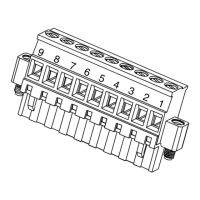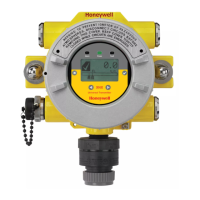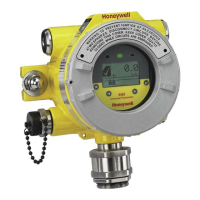XNX Universal Transmitter
Section 3 - Calibration
111
4. Follow the procedure in the Zero and Span Calibration for EC
Sensors, mV Sensors, and Searchpoint Optima section for
both zero and span calibrations.
5. Apply the target gas to the sensor. Pass the gas through the ow
housing at a rate of
300-700 ml/min.
6. Calibrate sensors at concentrations representative of those to
be measured. When feasible, calibrate the sensor with the target
gas it is to detect.
7. Ensure that the sensor and the vicinity around it is clear of all
traces of the calibration gas before continuing. This is to avoid
triggering spurious alarms. If the calibration fails at any point,
discard the cartridge and replace it with a new one (see the
MPD Sensor Cartridge Replacement section) .
8. Remove the test equipment, ret the weatherproof cap to the
sensor (if it was previously removed for the test), and return the
system to normal operation.
MPD Flammable Sensor Operational Life
The pellistors used in ammable gas sensors can suffer from a loss of
sensitivity when in the presence of poisons or inhibitors, e.g., silicones,
suldes, chlorine, lead, or halogenated hydrocarbons. The pellistors
are poison-resistant to maximize the operational life of the ammable
sensor. The typical operating life of the pellistor sensor used in the
MPD-CB1 is 60 months.
Cross-calibration Procedure for MPD-CB1
Caution: When a user calibrates a sensor using a different gas, the responsibility for identifying and
recording the calibration rests with the user. Refer to local regulations where appropriate.
When the MPD-CB1 Combustible LEL sensor is to be calibrated with a
gas which is different from the gas or vapor to be detected, follow this
cross-calibration procedure:
These star rating tables list the gases according to the reaction they
produce at a given detector.
Gas
Star
Rating
Gas
Star
Rating
Gas
Star
Rating
Acetone 4* Ethane 6* Nonane 2*
Ammonia 7* Ethanol 5* Octane 3*
Benzene 3* Ethyl acetate 3* Pentane 4*
Butanone 3* Ethylene 5* Propane 5*
Butane 4* Heptane 3* Propan-2-ol 4*
Butyl acetate 1* Hexane 3* Styrene 2*
Butyl acrylate 1* Hydrogen 6* Tetra hydrafuran 4*
Cyclohexane 3* Methane 6* Toluene 3*
Cyclohexanone 1* Methanol 5* Triethylamine 3*
Diethyl ether 4* MIBK 3* Xylene 2*
An eight-star (8*) gas produces the highest output, while a one-star (1*)
gas produces the lowest. (These are not applicable at ppm levels.)
To cross-calibrate the MPD-CB1 combustible gas sensor:
